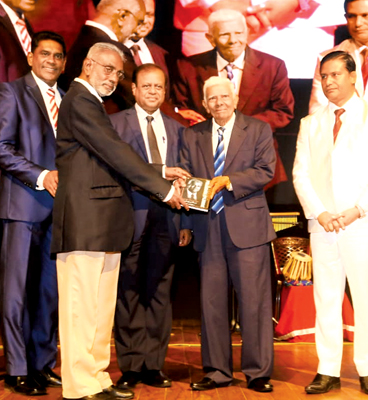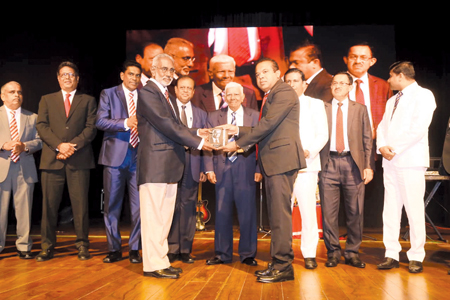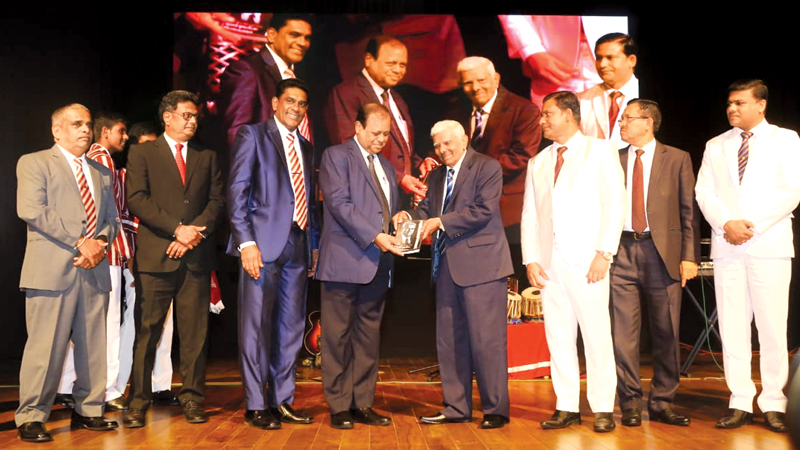While conducting his class at Nalanda College in Colombo, Sugthamuni Gnanasiri, a teacher, received a message relayed by a Grade 7 student. After reading the message, he directed Epasinghe from his class to promptly meet the school’s cricket teacher in charge, Kandasamy.
As Epasinghe nervously visits the teacher, he recalls his performance at the school’s sports meet held the day before. This was none other than Premasara Epasinghe, known as the “Golden Voice” of cricket in Sri Lanka.
Despite asserting that he had never played cricket before, he showcased a remarkable performance by hitting several fours, surprising the opponents. His team scored total 148 runs with his support. “I will never forget that day,” he said. It was this performance that earned him a summons from Kandasamy that day.
Childhood

The author presenting the book to Premasara Epasinghe.
In his childhood, young Epasinghe observed university students playing cricket at the Colombo University ground. Emulating what he saw, he played with a tennis ball at home. His performance at the inter-house match earned him a spot in the Nalanda cricket team.
He was selected as the team’s wicketkeeper and an opening batsman. He played in the 28th Battle of the Maroons along with contemporaries Gamini Jayawickrama Perera and Mithra Siriwardene.
Under the guidance of the team coach, who also coached the Saracens Cricket Club, Epasinghe transitioned into playing club cricket with clubs such as Saracens Cricket Club, Nondescripts Cricket Club, and the Bloomfield Cricket Club. However, his cricket career was short-lived as he gave it up in favour of pursuing university studies, influenced by the insistence of his uncle.
During his university studies, where he focused on Sinhala, English, History, and Education, Premasara Epasinghe remained connected to cricket. He played a pivotal role as a founding member of the first cricket team at Sri Jayewardenepura University. Notably, during the university season, Epasinghe showcased his skills beyond cricket and became the table tennis champion, highlighting his versatility in sports.
During his university days in 1958, he took on the role of an English teacher at Mahanama Vidyalaya in Colombo, becoming the first English teacher in the school at that time.
Simultaneously, he joined Lake House as a reporter. Juggling his responsibilities as a teacher in the morning and a reporter in the evening, Epasinghe actively contributed to news reporting at Lake House.
 This period allowed him to collaborate with prominent figures in journalism, including M. I. D. Silva, Cecil Graham, Elmo Gunaratne, D. C. Ranatunga, Meemana Premathilaka, S. Subasinghe, and Wimalasiri Perera. “During this period, the first-ever football match under electric lights took place at the Oval, initiated by R. Premadasa, who was a municipal councillor at that time.
This period allowed him to collaborate with prominent figures in journalism, including M. I. D. Silva, Cecil Graham, Elmo Gunaratne, D. C. Ranatunga, Meemana Premathilaka, S. Subasinghe, and Wimalasiri Perera. “During this period, the first-ever football match under electric lights took place at the Oval, initiated by R. Premadasa, who was a municipal councillor at that time.
Premadasa would personally drop me off at Lake House in his car. After covering the details of the match at the Oval, I would walk to my boarding in Colpetty thereafter.
This experience provided me with the opportunity to cultivate various facets of my media career. It was at Lake House that I gained valuable experience and exposure,” he said.
During that period, Nanda Jayamanna, in charge of the evening service, extended an invitation that opened the doors to the Sri Lanka Broadcasting Corporation (SLBC) for Epasinghe. This marked the beginning of Premasara Epasinghe’s journey as a cricket commentator.
In 1971, Epasinghe seized the opportunity to provide Sinhala commentary for the Royal Thomian Battle of the Blues. The senior officials appointed for this task by the SLBC were Palitha Perera, Amarbandhu Rupasinghe, and Thilaka Sudharman Silva. During this time, Epasinghe, who was still an apprentice, had the chance to commentate at the prestigious match, marking a significant new chapter in his life.
“I started my journey as a commentator on that day and continued until 2016. It has been 60 years now,” he reflected.
Epasinghe, not content with his achievements, embarked on a significant journey in 1985 as a commentator for the Sri Lanka-Pakistan Test series in Pakistan. This marked the first instance in the history of Sri Lanka Radio where live commentary from abroad was introduced.
Adding to his accolades, Epasinghe had the honour of commentating on the first Sri Lanka Test cricket match in 1982. Notably, he stands as a unique figure having provided commentary for both the 100th and 150th Test cricket matches in Sri Lanka.
Subsequently, he journeyed to all Test cricket-playing countries except the West Indies and graced the commentary booth alongside renowned commentators like Trevor Bailey, Peter Buster, Brian Johnson, Richie Benaud, and Tony Greig. Through his commentary, he has effectively conveyed the excitement, competitiveness, and enjoyment of those matches to listeners and spectators, bringing them so close that they feel connected to the live moments.
World Cup
Premasara Epasinghe considers the day Sri Lanka won the World Cup as the most memorable event in his life. He acknowledges the impartiality required of a commentator when it comes to their own country; at that moment, he sees himself as a neutral individual, vividly recalling how he navigated through that historic occasion.
“It was an incredibly emotional moment. Despite the immense joy, there was no outward way to express it. Australia scored 242 runs that day, but we successfully chased and secured the victory. I want to emphatically state that a cricket captain like Arjuna Ranatunga will not be born in this country again. Presently, there are no leaders who are willing to accept challenges,” said Premasara Epasinghe, reflecting on that historic occasion.
Given the extensive span of his career spanning decades, the rich details of Premasara Epasinghe’s journey cannot be adequately condensed into a mere article. Consequently, a comprehensive book has been released, titled ‘Premasara Epasinghe:
The Golden Voice of the Sri Lankan Cricket Field.’ Notably, this insightful work is authored by the esteemed journalist Atula Ranjith Vedamestri. The book not only delves into the personal narrative of Premasara Epasinghe but also offers a valuable perspective on the genealogy of cricket history in Sri Lanka.
Translated by Maneshka Borham
Pix By Chinthaka Kumarasinghe







